Market
Vitalik Buterin Promotes Ethereum Layer 2 Roadmap


Ethereum co-founder Vitalik Buterin has introduced a new roadmap aimed at strengthening the security and finality of Layer 2 (L2) solutions.
His proposal introduces a flexible, multi-proof system designed to support Ethereum’s scalability while preserving its core principles of decentralization and trust minimization.
Ethereum’s New Layer 2 Roadmap
At the heart of Buterin’s technical framework is a “2-of-3” model. This system uses three different proof types—optimistic, zero-knowledge (ZK), and trusted execution environment (TEE) provers.
A transaction is finalized when any two of these agree, significantly reducing the risk tied to relying on a single-proof method. The model offers a pragmatic balance between speed, robustness, and decentralization.
Buterin emphasized the importance of diversification, especially as zero-knowledge systems mature. He warned that shared code among ZK rollups could cause bugs to propagate across implementations, raising systemic risk.
“This means that the finality of rollups can be as fast as zk proving (~<1hr for now) while protecting the system from soundness bugs in the zk system,” Wei Dai, a research partner at 1kxnetwork, explained.
Meanwhile, Buterin’s roadmap also lays out the requirements for what he calls “Stage 2 rollups.” These next-generation rollups would deliver near-instant confirmations, high finality, and strong resistance to failures—even in semi-trusted environments.
Importantly, they would still adhere to Ethereum’s 30-day upgrade delay, a rule that safeguards the network’s stability during transitions.
Buterin Makes Case for Open-Source Funding
Beyond scalability, Buterin is also advocating a cultural shift in how the crypto community approaches development funding.
In a separate blog post, he suggested shifting the focus from “public goods funding” to “open-source funding.”
His concern is that the phrase “public goods” has become politically and socially loaded, often used in ways that prioritize perception over impact.
“A big part of the reason why the term ‘public good’ is vulnerable to social gaming is precisely the fact that the definition of ‘public good’ is stretched so easily,” Buterin argued
He noted that public goods funding is vulnerable to social desirability bias. This often favors those who can navigate community politics over those who deliver meaningful value.
In contrast, open-source funding emphasizes transparency, collaboration, and the building of tools that genuinely benefit the broader ecosystem.
Buterin believes that the goal should not be to fund any open-source project indiscriminately but to support those that create maximum value for humanity.
This stance aligns with his broader vision of a sustainable, community-driven blockchain infrastructure.
Together, Buterin’s proposals could redefine both the technical direction of Ethereum’s scalability efforts and the philosophical foundations of its funding strategies—reinforcing the network’s long-term commitment to decentralization, security, and public benefit.
Disclaimer
In adherence to the Trust Project guidelines, BeInCrypto is committed to unbiased, transparent reporting. This news article aims to provide accurate, timely information. However, readers are advised to verify facts independently and consult with a professional before making any decisions based on this content. Please note that our Terms and Conditions, Privacy Policy, and Disclaimers have been updated.
Market
This is Why PumpSwap Brings Pump.fun To the Next Level

Since launching PumpSwap, token launchpad Pump.fun has resumed its position as a top-level protocol by fees and revenue. It saw over $2.62 billion in volume in less than two weeks, signifying high market interest.
Nonetheless, the meme coin sector as a whole has been more volatile than usual lately. PumpSwap is an attractive new option, but it still needs to stand the test of time.
Pump.fun Surges with PumpSwap
Pump.fun, a prominent meme coin creation platform, recently suffered some difficulties in the market. Facing lawsuits and criticism from the industry, the platform’s revenue had been declining in 2025. However, since launching PumpSwap, Pump.fun’s income has rebounded, making it one of the largest protocols by fees and revenue.

PumpSwap is a decentralized exchange on Solana’s blockchain, and it has grown very quickly since its launch less than two weeks ago. It has already managed over $2.62 billion in trade volume, although its daily volume fell over the weekend. Pump.fun’s cofounder spoke highly about PumpSwap, calling it a “crucial step that will help grow the ecosystem.”
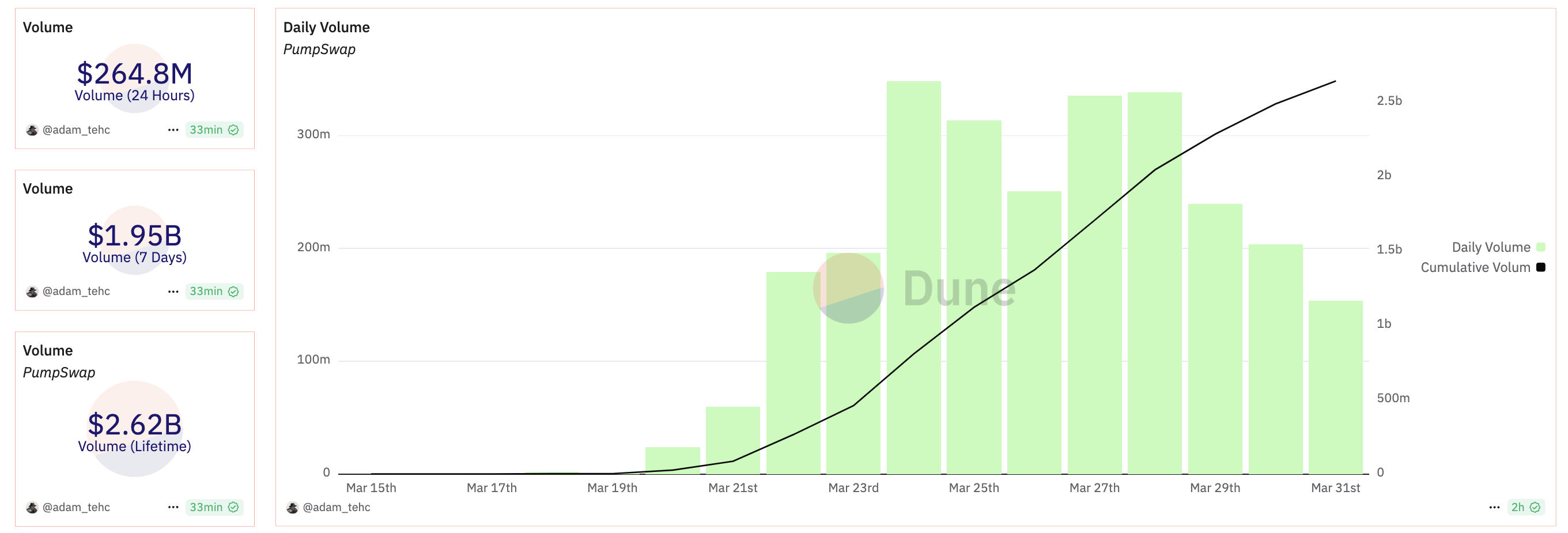
Pump.fun’s overall revenues were declining before it launched PumpSwap, and they have since jumped back up. However, it’s important to not overstate the new exchange’s success. The exchange’s total fees collected have skyrocketed compared to Pump.fun, but the actual revenue growth has been comparatively small.
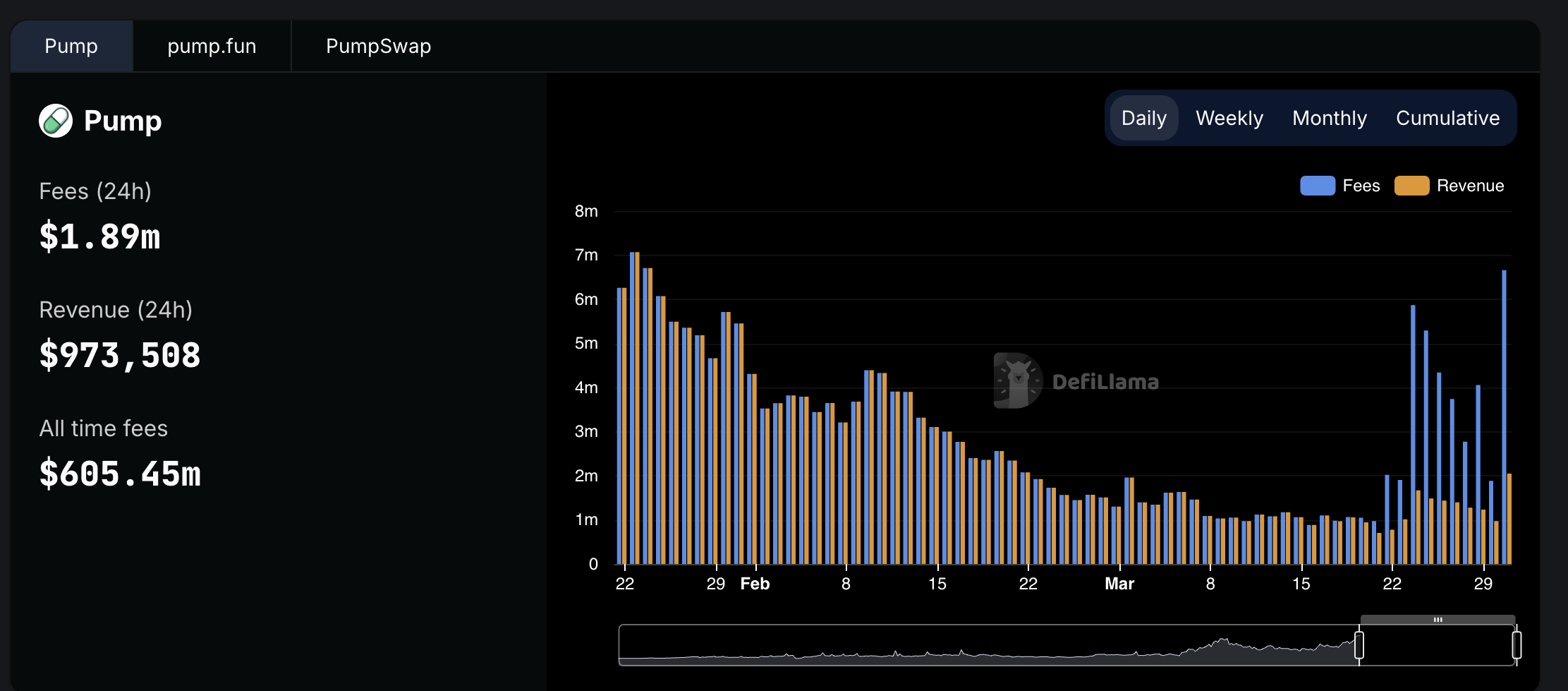
Still, these low fees also have significant advantages. Demand seems to be drying up in the meme coin sector, but Pump.fun faces stiff competition in the form of firms like Raydium, using low fees as a competitive edge. It has also promised things like revenue sharing with token creators to promote ecosystem growth.
Ultimately, the meme coin market as a whole is full of uncertainty. PumpSwap has been able to keep Pump.fun competitive as a top-level platform in this space, giving it a welcome reprieve. The real challenge will come in determining long-term viability.
Disclaimer
In adherence to the Trust Project guidelines, BeInCrypto is committed to unbiased, transparent reporting. This news article aims to provide accurate, timely information. However, readers are advised to verify facts independently and consult with a professional before making any decisions based on this content. Please note that our Terms and Conditions, Privacy Policy, and Disclaimers have been updated.
Market
Hedera (HBAR) Bears Dominate, HBAR Eyes Key $0.15 Level
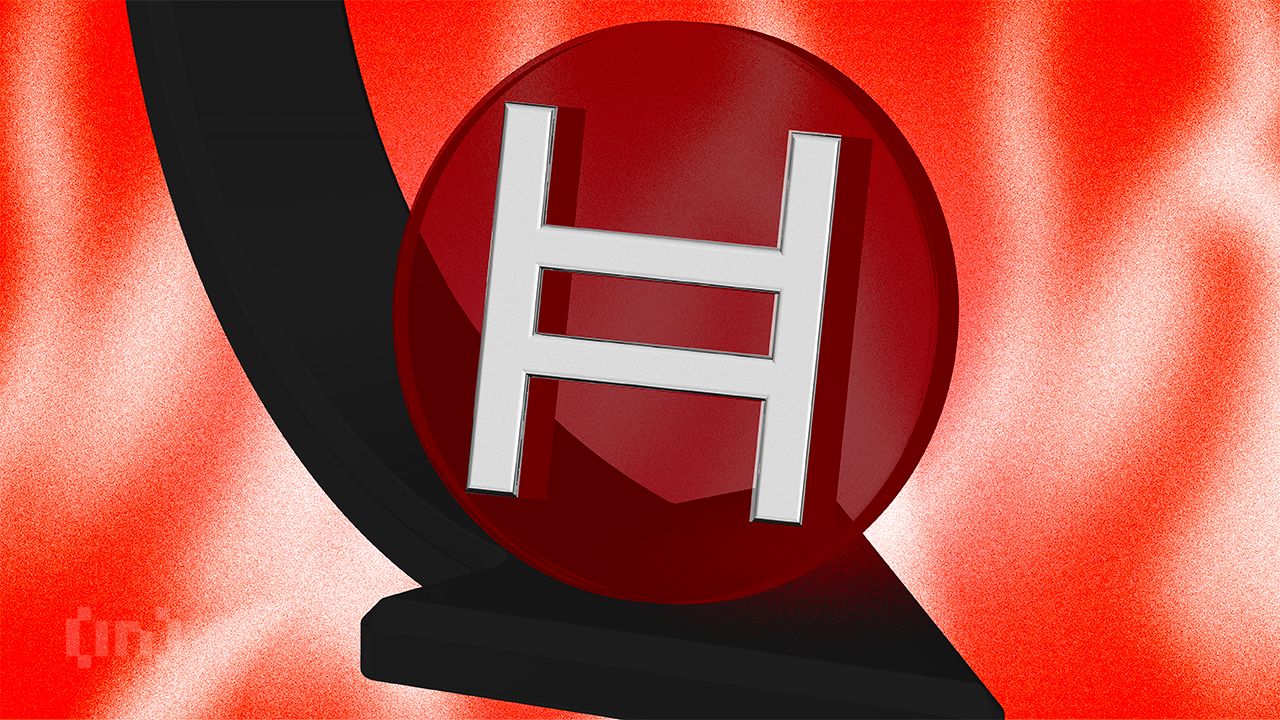
Hedera (HBAR) is under pressure, down roughly 13.5% over the past seven days, with its market cap holding at around $7 billion. Recent technical signals point to growing bearish momentum, with both trend and momentum indicators leaning heavily negative.
The price has been hovering near a critical support zone, raising the risk of a breakdown below $0.15 for the first time in months. Unless bulls regain control soon, HBAR could face further losses before any meaningful recovery attempt.
HBAR BBTrend Has Been Turning Heavily Down Since Yesterday
Hedera’s BBTrend indicator has dropped sharply to -10.1, falling from 2.59 just a day ago. This rapid decline signals a strong shift in momentum and suggests that HBAR is experiencing an aggressive downside move.
Such a steep drop often reflects a sudden increase in selling pressure, which can quickly change the asset’s short-term outlook.
The BBTrend, or Bollinger Band Trend, measures the strength and direction of a trend using the position of price relative to the Bollinger Bands. Positive values generally indicate bullish momentum, while negative values point to bearish momentum.

The further the value is from zero, the stronger the trend. HBAR’s BBTrend is now at -10.1, signaling strong bearish momentum.
This suggests that the price is trending lower and doing so with increasing strength, which could lead to further downside unless buyers step in to slow the momentum.
Hedera Ichimoku Cloud Paints a Bearish Picture
Hedera’s Ichimoku Cloud chart reflects a strong bearish structure, with the price action positioned well below both the blue conversion line (Tenkan-sen) and the red baseline (Kijun-sen).
This setup indicates that short-term momentum is clearly aligned with the longer-term downtrend.
The price has consistently failed to break above these dynamic resistance levels, signaling continued seller dominance.
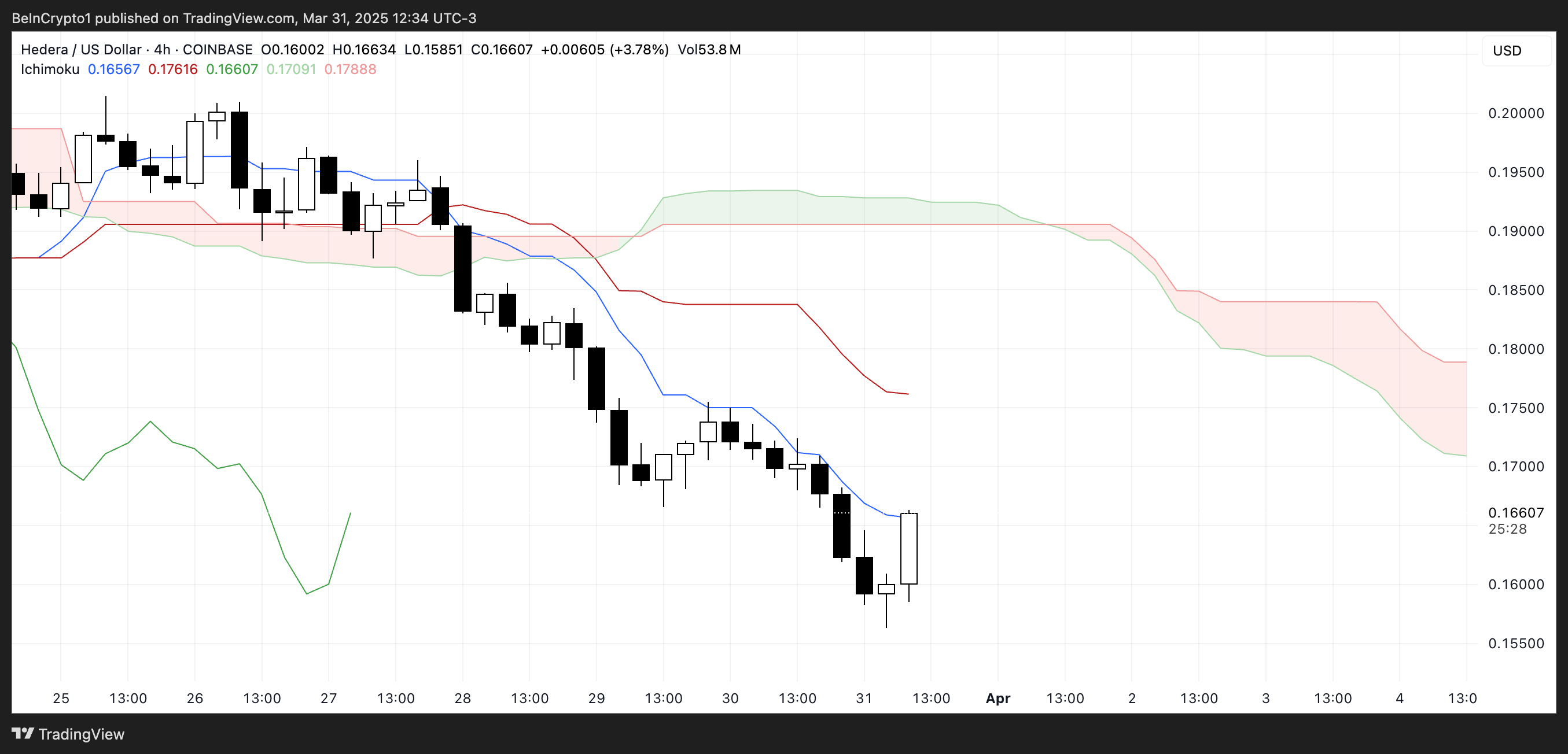
The future cloud is also red and trending downward, suggesting that bearish pressure is expected to persist in the near term.
The span between the Senkou Span A and B lines remains wide, reinforcing the strength of the downtrend. For any potential reversal to gain credibility, HBAR would first need to challenge and break above the Tenkan-sen and Kijun-sen, and eventually push into or above the cloud.
Until then, the current Ichimoku configuration supports a continuation of the bearish outlook.
Can Hedera Fall Below $0.15 Soon?
Hedera price has been hovering around the $0.16 level and is approaching a key support at $0.156.
If this support fails to hold, it could open the door for further downside, potentially pushing HBAR below the $0.15 mark for the first time since November 2024.
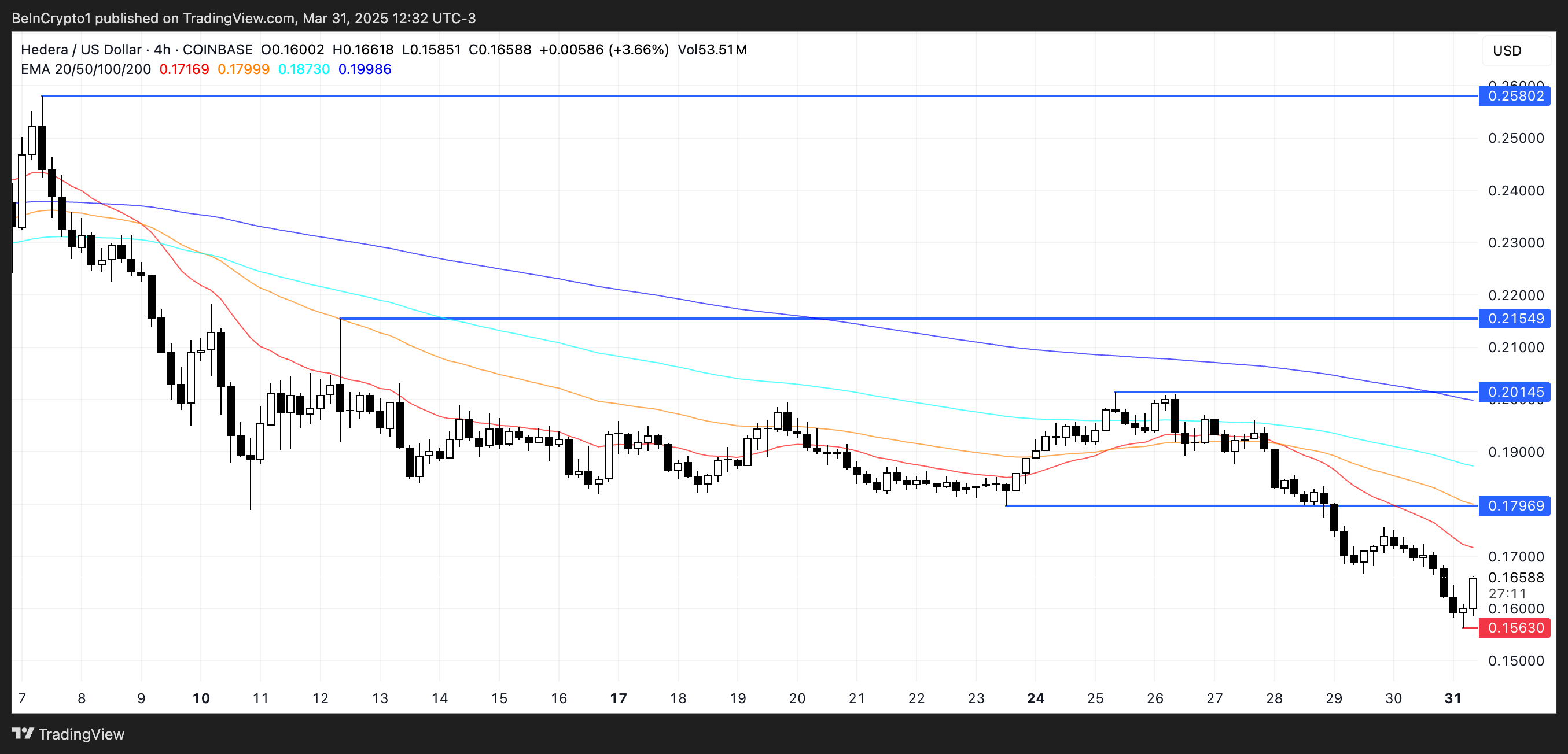
However, if HBAR manages to reverse its current trajectory and regain bullish momentum, the first target to watch is the resistance at $0.179.
A breakout above that level could lead to a stronger rally toward $0.20 and, if momentum continues, even reach $0.215. In a more extended bullish scenario, HBAR could climb to $0.25, signaling a full recovery and trend reversal.
Disclaimer
In line with the Trust Project guidelines, this price analysis article is for informational purposes only and should not be considered financial or investment advice. BeInCrypto is committed to accurate, unbiased reporting, but market conditions are subject to change without notice. Always conduct your own research and consult with a professional before making any financial decisions. Please note that our Terms and Conditions, Privacy Policy, and Disclaimers have been updated.
Market
Coinbase Tries to Resume Lawsuit Against the FDIC


Coinbase asked a DC District Court if it could resume its old lawsuit against the FDIC. Coinbase sued this regulator over Operation Choke Point 2.0 and claimed that it’s still refusing to release relevant information.
Based on the information available so far, it’s difficult to draw definitive conclusions. The FDIC maintains that it responded to its opponents’ questions truthfully, though it has shown delays in the past.
Coinbase vs the FDIC
Coinbase, one of the world’s largest crypto exchanges, has been in a few fights with the FDIC. The firm has been pursuing the FDIC over Operation Choke Point 2.0 for months now, and has achieved impressive results. Despite this, however, Coinbase is asking the DC District Court to resume its litigation against the regulator:
“We’re asking the Court to resume our lawsuit because the FDIC has unfortunately stopped sharing information. While we would have loved to resolve this outside of the legal system – and we do appreciate the increased cooperation we’ve seen from the new FDIC leadership – we still have a ways to go,” claimed Paul Grewal, Coinbase’s Chief Legal Officer.
The FDIC has an important role in US financial regulation, primarily dealing with banks. This gave it a starring role in Operation Choke Point 2.0, hampering banks’ ability to deal with crypto businesses. However, it recently started a pro-crypto turn, releasing tranches of incriminating documents and revoking several of its anti-crypto statutes.
Grewal said that he “appreciated the increased cooperation” from the FDIC but that the cooperation stopped weeks ago. According to Coinbase’s filing, the FDIC hasn’t sent any new information since late February and claimed in early March that the exchange’s subsequent requests were “unreasonable and beyond the scope of discovery.”
On one hand, the FDIC has previously been slow to make relevant disclosures in the Coinbase lawsuit. On the other hand, Operation Choke Point 2.0 sparked significant tension within the industry, and a determined group is now aiming to significantly weaken the regulatory bodies involved.
Until the legal battle continues, it’ll be difficult to make any definitive statements. The FDIC will likely have two weeks to respond to Coinbase’s request.
Disclaimer
In adherence to the Trust Project guidelines, BeInCrypto is committed to unbiased, transparent reporting. This news article aims to provide accurate, timely information. However, readers are advised to verify facts independently and consult with a professional before making any decisions based on this content. Please note that our Terms and Conditions, Privacy Policy, and Disclaimers have been updated.
-

 Market20 hours ago
Market20 hours agoBitcoin Bears Tighten Grip—Where’s the Next Support?
-

 Market19 hours ago
Market19 hours agoEthereum Price Weakens—Can Bulls Prevent a Major Breakdown?
-

 Market14 hours ago
Market14 hours agoDon’t Fall for These Common Crypto Scams
-

 Ethereum8 hours ago
Ethereum8 hours agoEthereum Price Confirms Breakout From Ascending Triangle, Target Set At $7,800
-
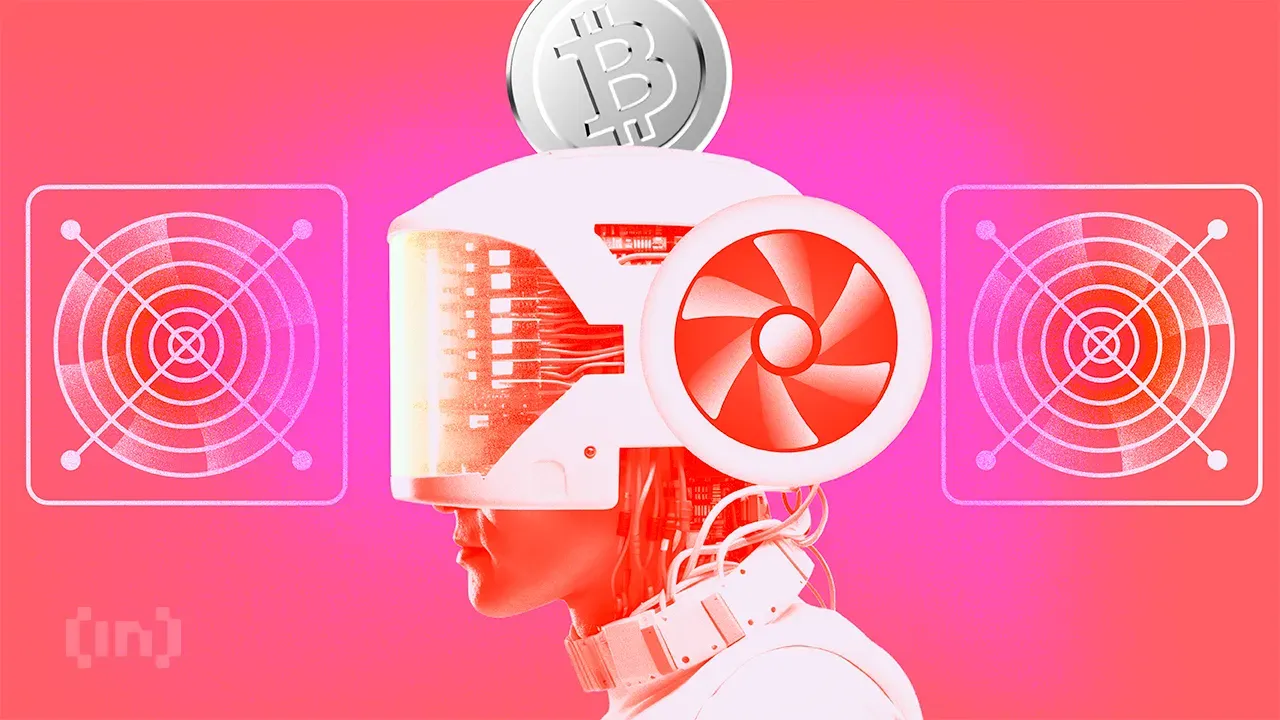
 Bitcoin13 hours ago
Bitcoin13 hours agoMarathon Digital to Sell $2 Billion in Stock to Buy Bitcoin
-

 Bitcoin7 hours ago
Bitcoin7 hours agoStrategy Adds 22,048 BTC for Nearly $2 Billion
-

 Market12 hours ago
Market12 hours agoStrategic Move for Trump Family in Crypto
-
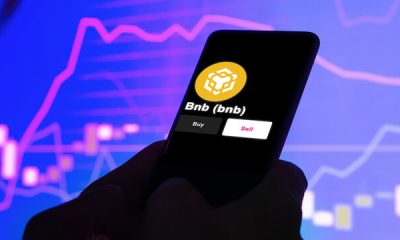
 Market7 hours ago
Market7 hours agoBNB Breaks Below $605 As Bullish Momentum Fades – What’s Next?




















